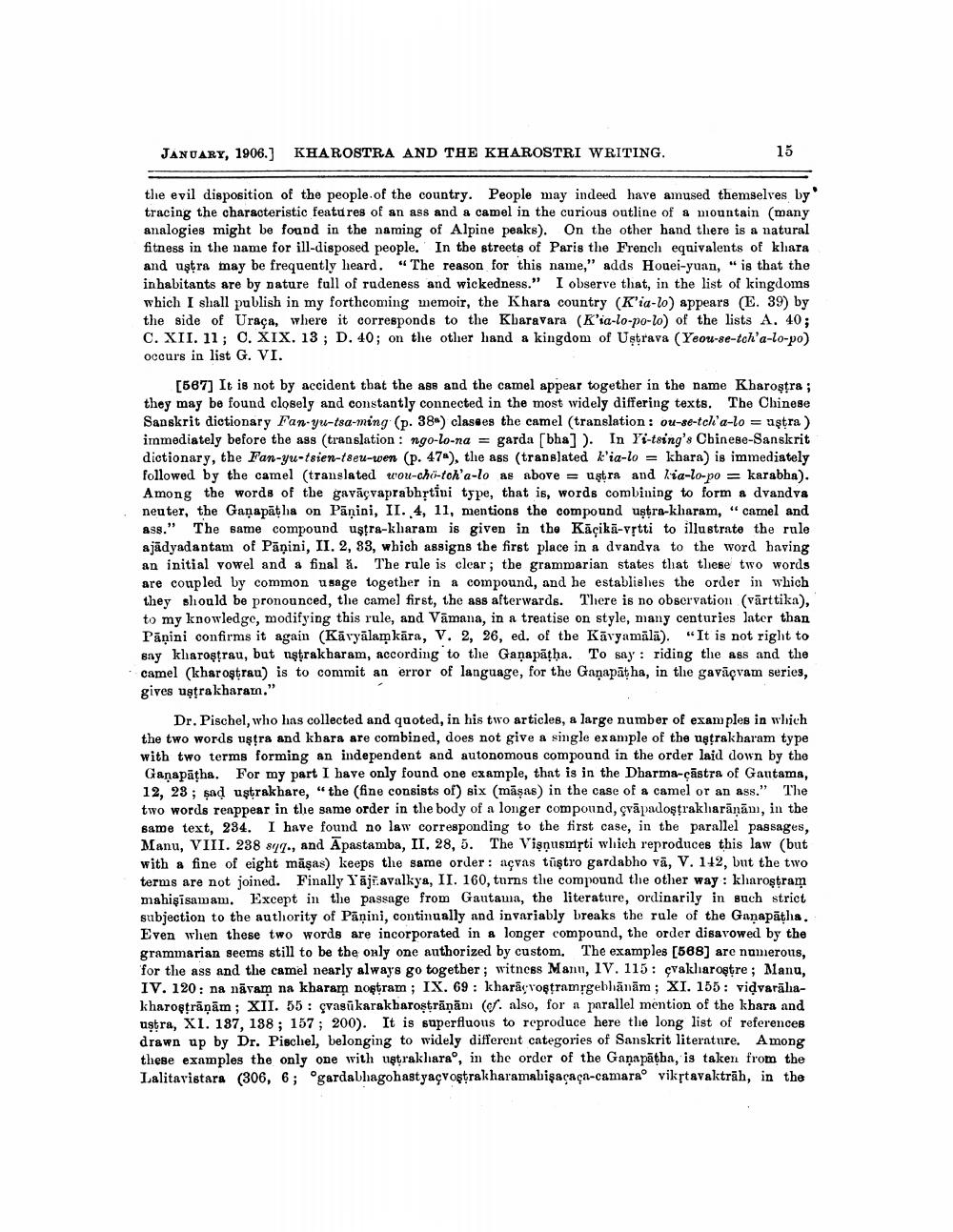________________
JANUARY, 1906.) KHAROSTRA AND THE KHAROSTRI WRITING.
15
the evil disposition of the people of the country. People may indeed have amused themselves by tracing the characteristic features of an ass and a camel in the curious outline of a mountain (many analogies might be found in the naming of Alpine peaks). On the other hand there is a natural fitness in the name for ill-disposed people. In the streets of Paris the French equivalents of klara and uştra may be frequently heard. “The reason for this name," adds Houei-yuan," is that the inhabitants are by Dature full of rudeness and wickedness." I observe that, in the list of kingdoms which I shall publish in my forthcoming memoir, the Khara country (K'ia-lo appears (E. 39) by the side of Uraça, where it corresponds to the Kharavara (K'ia-lo-po-lo) of the lists A. 40; C. XII. 11; C. XIX. 13; D. 40; on the other hand a kingdom of Uştrava (Yeou-se-tch'a-lo-yo) occurs in list G. VI.
[567] It is not by accident that the ass and the camel appear together in the name Kharoştra ; they may be found closely and constantly connected in the most widely differing texts. The Chinese Sanskrit dictionary Fan-yu-tsa-ming (p. 38) clases the camel (translation : ou-88-tcli'a-lo = aştra) immediately before the ass (translation: ngo-lo-na = garda bha]). In Yi-tsing's Chinese-Sanskrit dictionary, the Fan-yu-tsien-t8eu-wen (p. 47), the ass (translated k'ia-lo = khara) is immediately followed by the camel (translated wou-chö-tch'a-lo as above = uştra and kia-lo-po = karabha). Among the words of the gavāçvaprabhrtini type, that is, words combining to form a dvandva neuter, the Gaņapātha on Pāņini, II. 4, 11, mentions the compound uştra-kharam, “camel and ass." The same compound ustra-kharam is given in the Kāçikā-vrtti to illustrate the rule ajādyadantam of Pāṇini, II. 2, 83, which assigns the first place in a dvandya to the word having an initial vowel and a final a. The rule is clear; the grammarian states that these two words are coupled by common usage together in a compound, and he establishes the order in which they should be pronounced, the camel first, the ass afterwards. There is no observation (vārttika), to my knowledge, modifying this rule, and Vamana, in a treatise on style, many centuries later than Pāṇini confirms it again (Kāryālamkāra, V. 2, 26, ed. of the Kāvyamālā). "It is not right to say kliaroştrau, but ustrakharam, according to the Ganapātha. To say: riding the ass and the camel (kharoştrau) is to commit an error of language, for the Ganapatha, in the gavāçvam series, gives uştrakharam."
Dr. Pischel, who has collected and quoted, in his two articles, a large number of examples in which the two words uşțra and kbara are combined, does not give a single example of the uętrak haram type with two terms forming an independent and autonomous compound in the order laid down by the Ganapatha. For my part I have only found one example, that is in the Dharma-cāstra of Gautama, 12, 23; sad ustrakhare, “the (fine consists of) six (māşas) in the case of a camel or an ass." The two words renppear in the same order in the body of a longer compound, gvāpadoştraklarāņām, in the same text, 234, I have found no law corresponding to the first case, in the parallel passages, Manu, VIII. 288 sqq., and Apastamba, II, 28, 5. The Vişnusmrti which reproduces this law (but with a fine of eight māşas) keeps the same order : acvas tūştro gardabho vā, V. 112, but the two terms are not joined. Finally Yājiavalkya, II. 160, turns the compound the other way: kharoştram mahişīsamam. Except in the passage from Gautama, the literature, ordinarily in such strict subjection to the authority of Pāņini, continually and invariably breaks the rule of the Ganapātha. Even when these two words are incorporated in a longer compound, the order disavowed by the grammarian seems still to be the only one authorized by custom. The examples (568) are namerous, for the ass and the camel nearly always go together; witness Mann, 1V. 115 : çvakharoştre; Manu, IV. 120: na nāvam na kharam noftram ; IX. 69: kharācroftramrgeblānām; XI. 155 : vidvarālakharoştrāņām; XII. 55 : çvasükarakharostrāņām (c. also, for a parallel mention of the khara and ustra, XI. 187, 188; 157; 200). It is superfluous to reproduce here the long list of references drawn up by Dr. Pischel, belonging to widely different categories of Sanskrit liternture. Among these examples the only one with ustrakhara, in the order of the Gaņapātba, is taken from the Lalitavistara (306, 6; Ogardalhagohastyaçvostrakharamabişacaça-camarao vikytavaktrāh, in the




